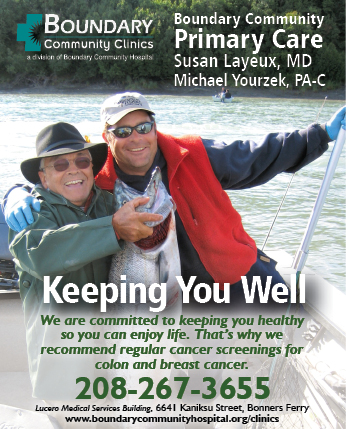Early Detection
Early Detection – Tests That Can Save Your Life
By: Susan Layeux, MD
Boundary Community Clinic Medical Director
March 2020 Bonners Ferry Living Local
 Screening for the most common cancers is highly recommended by organizations like the American Cancer Society (ACS), the American Academy of Family Physicians (AAFP) and the U.S. Preventive Services Task Force (USPSTF). As primary care providers, it is our goal to detect treatable cancers early, to decrease the burden of disease and death.
Screening for the most common cancers is highly recommended by organizations like the American Cancer Society (ACS), the American Academy of Family Physicians (AAFP) and the U.S. Preventive Services Task Force (USPSTF). As primary care providers, it is our goal to detect treatable cancers early, to decrease the burden of disease and death.
Many people decline screening tests because they do not have symptoms. But the reality is, most cancers do NOT have symptoms in their early stages, when they are the most curable.
The four most common cancers are: Prostate (in men), Breast (in women), Lung, and Colorectal cancer.
Lung cancer accounts for more cancer deaths than colorectal, breast and prostate cancer combined.
Some current screening recommendations:
- LUNG cancer screening is recommended for any person age 55-80 who has smoked the equivalent of 1 pack per day of cigarettes for 30 or more years, and is either still smoking or quit less than 15 years ago. That is done with a limited (lower radiation dose) CT scan of the lungs.
- COLORECTAL cancer screening is recommended for all adults aged 50-75. The three most common ways to screen: 1) Colonoscopy every 10 years; 2) a stool test for blood and DNA shed from cancerous/precancerous cells (current one on market is Cologuard) every 3 years; 3) or a stool test for blood, every year. Colonoscopy is still considered the “gold standard”, and people must understand that if they have a positive screen in one of the stool tests, a diagnostic Colonoscopy will then be recommended.
- BREAST cancer screening is recommended for all women from ages 50-75 using a 3-D Mammogram. The various societies have disagreement with how often to screen between the ages of 40-50, and the interval of screening (every 1 or 2 years). Much depends on family history.
- PROSTATE cancer screening recommendations have changed. The only current available test is a blood test called PSA (prostate specific antigen), used to test men from ages 55-69. However, it is an inadequate screen because a high PSA is not only seen with cancer. It can be high because of an enlarged prostate or a prostate infection. Screening is individualized based on your history.
The details about benefits and risks of each type of screen can be found on the USPSTF website www.uspreventiveservicestaskforce.org. They give the recommendations for the average person as well as every exception. Our goal at the Boundary Community Clinics is to keep current with the guidelines and present each patient with the best recommended screening based on their personal and family history, and to answer questions about risks. The good news is, Medicare and most commercial insurances cover screening costs at 80-100%.
Early cancer detection saves lives. Please do not wait until you have symptoms to be screened. Talk to your Primary Care Provider about what screens are right for you.
